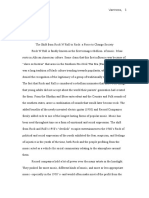0 ratings0% found this document useful (0 votes)
136 viewsHistory of Television
History of Television
Uploaded by
Yeny Rivas CerónThe television has become an integral part of modern homes and provides entertainment and information. Early experiments in electricity and radio in the late 1800s laid the foundations for television's invention. Paul Nipkow developed the first mechanical television using a rotating disk in the 1880s. Mechanical television systems then emerged but were replaced by electronic television, which used electronics instead of moving parts, pioneered by Philo Farnsworth in 1927. Electronic television became the basis for modern televisions and color was later added.
Copyright:
Attribution Non-Commercial (BY-NC)
Available Formats
Download as DOC, PDF, TXT or read online from Scribd
History of Television
History of Television
Uploaded by
Yeny Rivas Cerón0 ratings0% found this document useful (0 votes)
136 views1 pageThe television has become an integral part of modern homes and provides entertainment and information. Early experiments in electricity and radio in the late 1800s laid the foundations for television's invention. Paul Nipkow developed the first mechanical television using a rotating disk in the 1880s. Mechanical television systems then emerged but were replaced by electronic television, which used electronics instead of moving parts, pioneered by Philo Farnsworth in 1927. Electronic television became the basis for modern televisions and color was later added.
Copyright
© Attribution Non-Commercial (BY-NC)
Available Formats
DOC, PDF, TXT or read online from Scribd
Share this document
Did you find this document useful?
Is this content inappropriate?
The television has become an integral part of modern homes and provides entertainment and information. Early experiments in electricity and radio in the late 1800s laid the foundations for television's invention. Paul Nipkow developed the first mechanical television using a rotating disk in the 1880s. Mechanical television systems then emerged but were replaced by electronic television, which used electronics instead of moving parts, pioneered by Philo Farnsworth in 1927. Electronic television became the basis for modern televisions and color was later added.
Copyright:
Attribution Non-Commercial (BY-NC)
Available Formats
Download as DOC, PDF, TXT or read online from Scribd
Download as doc, pdf, or txt
0 ratings0% found this document useful (0 votes)
136 views1 pageHistory of Television
History of Television
Uploaded by
Yeny Rivas CerónThe television has become an integral part of modern homes and provides entertainment and information. Early experiments in electricity and radio in the late 1800s laid the foundations for television's invention. Paul Nipkow developed the first mechanical television using a rotating disk in the 1880s. Mechanical television systems then emerged but were replaced by electronic television, which used electronics instead of moving parts, pioneered by Philo Farnsworth in 1927. Electronic television became the basis for modern televisions and color was later added.
Copyright:
Attribution Non-Commercial (BY-NC)
Available Formats
Download as DOC, PDF, TXT or read online from Scribd
Download as doc, pdf, or txt
You are on page 1of 1
History of television
The television has become such an integral part of homes
in the modern world that it is hard to imagine life without
television. The television provides entertainment to people of all
ages. Not just for entertainment value, but TV is also a valuable
resource for advertising and different kinds of programming. The
television as we see it and know it today was not always this way.
Let’s take a brief look at the history of television and how it came
into being.
Timeline of TV History
Different experiments by various people, in the field of
electricity and radio, led to the development of basic technologies
and ideas that laid the foundation for the invention of television.
In the late 1800s, Paul Gottlieb Nipkow, a student in
Germany, developed the first ever mechanical module of television.
He succeeded in sending images through wires with the help of a
rotating metal disk. This technology was called the ‘electric
telescope’.
Around 1907, two separate inventors, A.A. Campbell-
Swinton from England and Russian scientist Boris Rosing, used
other inventions to create a new television system.
From the experiments of Nipkow and Rosing, two types of
television systems came into existence: mechanical television and
electronic television.
Mechanical Television History
In 1923, an American inventor called Charles Jenkins used
the disk idea of Nipkow to invent the first ever practical mechanical
television system. By 1931, his model 100 was being sold in a
complete kit as a mechanical television.
In 1926, just a little after Jenkins, a British inventor known
as John Logie Baird, was the first person to have succeeded in
transmitting moving pictures through the mechanical disk system
started by Nipkow. He also started the first ever TV studio.
From 1926 till 1931, the mechanical television system saw
many innovations. Although the discoveries of these men in the
department of mechanical television were very innovative, by 1934,
all television systems had converted into the electronic system,
which is what is being used even today.
Electronic Television History
The experiments of Swinton in 1907 held great potential
but were not converted into reality. Finally, in 1927, Philo Taylor
Farnsworth was able to invent a working model of electronic
television that was based on Swinton’s ideas.
His experiments started when he was just a little boy of 14
years. By the time he became 21, Philo created the first electronic
television system, which did away with the rotating disks and other
mechanical aspects of mechanical television. Thus was born the
television system which is the basis of all modern TVs.
All the early television systems were black and white,
with color television being invented much later on. Since the early
invention of television in the beginning of the 1900s, history has
seen many changes in the area of television.
You might also like
- India Sports MPD Channels ListDocument13 pagesIndia Sports MPD Channels ListSpartan PraveenNo ratings yet
- Reader Report On Jane Feuer's Concept of Live TV, Ontology As IdeologyDocument3 pagesReader Report On Jane Feuer's Concept of Live TV, Ontology As IdeologyVeerla84No ratings yet
- A European Television HistoryDocument454 pagesA European Television HistoryEmmanuel Labat100% (1)
- Madonna Queen of Pop: A Case Study: Is She Still Reigning The Pop ?Document8 pagesMadonna Queen of Pop: A Case Study: Is She Still Reigning The Pop ?Sharifah NorlizaNo ratings yet
- The History of TelevisionDocument2 pagesThe History of TelevisionChhayaLoveStudyNo ratings yet
- The History of TelevisionDocument2 pagesThe History of TelevisionTô Nguyễn Quốc CườngNo ratings yet
- The History of TelevisionDocument2 pagesThe History of TelevisionDurai Mani100% (1)
- History of TelevisionDocument11 pagesHistory of TelevisionGerald GavinaNo ratings yet
- "Television Cable and Other Multi-Channel Services": Polytechnic University of The PhilippinesDocument11 pages"Television Cable and Other Multi-Channel Services": Polytechnic University of The PhilippinesDexter CaroNo ratings yet
- History of TelevisionDocument23 pagesHistory of TelevisionSheen J PNo ratings yet
- Televisions Can Be Found in Billions of Homes Around The WorldDocument13 pagesTelevisions Can Be Found in Billions of Homes Around The WorldPriya SelvakumarNo ratings yet
- Evolution of TVDocument28 pagesEvolution of TVdakter esseNo ratings yet
- TelevisionDocument60 pagesTelevisionAfaq AhmadNo ratings yet
- History of TV AdvertisingDocument1 pageHistory of TV AdvertisingDemimasonNo ratings yet
- Television HistoryDocument5 pagesTelevision HistoryRodrigo Muñoz Jimenez100% (1)
- John Baird (1888 - 1946) Invented A Mechanical Television SystemDocument2 pagesJohn Baird (1888 - 1946) Invented A Mechanical Television SystemCretuCosminNo ratings yet
- Boris Rosing Vladimir Zworykin Braun Cathode Ray TubeDocument2 pagesBoris Rosing Vladimir Zworykin Braun Cathode Ray TubefunmastiNo ratings yet
- Turkish Television Broadcasting 2011Document118 pagesTurkish Television Broadcasting 2011Julien ParisNo ratings yet
- Television Industry: Presented By: Sanjeev Kumar Dsbspgdma1149Document42 pagesTelevision Industry: Presented By: Sanjeev Kumar Dsbspgdma1149Gopal PandeyNo ratings yet
- Nielsen Music 2011 UpdateDocument10 pagesNielsen Music 2011 UpdateBMX Entertainment CorporationNo ratings yet
- Television HistoryDocument5 pagesTelevision HistoryJaider Mercado López100% (1)
- TelevisionDocument31 pagesTelevisionrjnnvpNo ratings yet
- History of BroadcastingDocument47 pagesHistory of BroadcastingLiyana NasarudinNo ratings yet
- The Invention of TelevisionDocument14 pagesThe Invention of TelevisionAmbar BenavidesNo ratings yet
- Krauss 2 Moments From The Post-Medium ConditionDocument8 pagesKrauss 2 Moments From The Post-Medium ConditionThomas GolsenneNo ratings yet
- Fun Anxious Tik Tok Video Compilation Remix Songs Comedy EntertainmentDocument9 pagesFun Anxious Tik Tok Video Compilation Remix Songs Comedy EntertainmentfunanxiousNo ratings yet
- Music Video Analysis MJDocument9 pagesMusic Video Analysis MJ07morgandomNo ratings yet
- RadioDigest 24-11-15Document42 pagesRadioDigest 24-11-15Enache DanielNo ratings yet
- An Introduction To Television - Hylander - 1941Document236 pagesAn Introduction To Television - Hylander - 1941ResistorNo ratings yet
- Evolution of Cable TelevisionDocument59 pagesEvolution of Cable Televisioneuge_prime2001No ratings yet
- Week 1 SlidesDocument32 pagesWeek 1 SlidesJuan CarlosNo ratings yet
- History of Indian TelevisionDocument4 pagesHistory of Indian TelevisionK Moshilpha CharangaNo ratings yet
- Satellite TV System - HowStuffWorks PDFDocument4 pagesSatellite TV System - HowStuffWorks PDFhanishsingla0241100% (1)
- History of TelevisionDocument8 pagesHistory of TelevisionHestia NyxiNo ratings yet
- History of Advertising in ImagesDocument33 pagesHistory of Advertising in ImagessimalauraNo ratings yet
- Syllabus: Digital Media Economics at UNC School of Journalism and Mass CommunicationDocument9 pagesSyllabus: Digital Media Economics at UNC School of Journalism and Mass CommunicationRyan Thornburg100% (1)
- Music TelevisionDocument2 pagesMusic TelevisionAreli FranciscoNo ratings yet
- TV HistoryDocument30 pagesTV HistoryAby AugustineNo ratings yet
- Introduction To CATVDocument20 pagesIntroduction To CATVkumarsanjeev.net9511No ratings yet
- History of The Eurovision Song ContestDocument9 pagesHistory of The Eurovision Song ContestNajda DurmoNo ratings yet
- British Broadcasting Corporation (BBC) - A General Analysis: Early YearsDocument3 pagesBritish Broadcasting Corporation (BBC) - A General Analysis: Early YearsNerv RulzNo ratings yet
- Digital Terrestrial Television BroadcastingDocument12 pagesDigital Terrestrial Television BroadcastingTristan James ConstantinoNo ratings yet
- History & Growth of TelevisionDocument32 pagesHistory & Growth of TelevisionAmos JacobNo ratings yet
- BAJC2021 Basics of New Media - 1 (C) PDFDocument11 pagesBAJC2021 Basics of New Media - 1 (C) PDFMs. Suruchi AgrawalNo ratings yet
- Radio BroadcastingDocument3 pagesRadio BroadcastingPhim ChanNo ratings yet
- History of AdvertisingDocument13 pagesHistory of AdvertisingSvetlana Vecher0% (1)
- Convergence JournalismDocument34 pagesConvergence Journalismali3800No ratings yet
- Computers in Broadcast & Cable NewsroomsDocument187 pagesComputers in Broadcast & Cable NewsroomsherooftitNo ratings yet
- Rock and Roll Paradigm ShiftDocument10 pagesRock and Roll Paradigm Shiftapi-316097275No ratings yet
- The Internet Radio Marketplace: Who Listens, Where, and Why You Should Care-GroupM Next-ResearchDocument8 pagesThe Internet Radio Marketplace: Who Listens, Where, and Why You Should Care-GroupM Next-ResearchGroupM_NextNo ratings yet
- Advertising in Electronic MediaDocument19 pagesAdvertising in Electronic Medianomi71_310075388100% (1)
- Music Video TreatmentDocument4 pagesMusic Video Treatmentapi-425403549No ratings yet
- Television Broadcast and BeyondDocument34 pagesTelevision Broadcast and BeyondApril SurNo ratings yet
- TVDocument117 pagesTVTnek OrarrefNo ratings yet
- Entertaining television: The BBC and popular television culture in the 1950sFrom EverandEntertaining television: The BBC and popular television culture in the 1950sNo ratings yet
- A Study of The Informal Music Industry in AfricaDocument96 pagesA Study of The Informal Music Industry in Africamoses_sitatiNo ratings yet
- History of Television in IndiaDocument16 pagesHistory of Television in IndiaBalamurali KrishnanNo ratings yet
- Social Media EconomicDocument191 pagesSocial Media EconomicEdhie WibowoNo ratings yet
- World Sales 2000Document7 pagesWorld Sales 2000iop8888100% (1)
- FER On AajtakDocument26 pagesFER On AajtakDiksha MehtaNo ratings yet
- I-. Listen and Write The Numbers You Hear (5 PTS)Document1 pageI-. Listen and Write The Numbers You Hear (5 PTS)Yeny Rivas CerónNo ratings yet
- Self Evaluation of Work Habits and BehaviourDocument1 pageSelf Evaluation of Work Habits and BehaviourYeny Rivas CerónNo ratings yet
- English Guide Unit 3: "We Are What We Eat"Document2 pagesEnglish Guide Unit 3: "We Are What We Eat"Yeny Rivas CerónNo ratings yet
- DiwaliDocument2 pagesDiwaliYeny Rivas CerónNo ratings yet
- Was and Were WorksheetDocument2 pagesWas and Were WorksheetYeny Rivas Cerón0% (1)
- Manual de Entrenamiento Cl21k40mq Chasis Ks9cDocument33 pagesManual de Entrenamiento Cl21k40mq Chasis Ks9cNelson Muñoz BautistaNo ratings yet
- Antcom L1 L2 GPS AntennasDocument194 pagesAntcom L1 L2 GPS AntennasAnonymous cDWQYsjd9No ratings yet
- IMO Model Course 1.26 (ROC) Draft Ed.2016Document224 pagesIMO Model Course 1.26 (ROC) Draft Ed.2016Jorge100% (2)
- Libro 1Document6 pagesLibro 1Martin CarvajalNo ratings yet
- Arrl 1977 Radio Amateur HandbookDocument708 pagesArrl 1977 Radio Amateur HandbookJorge Jockyman JuniorNo ratings yet
- Parabolic AntennaDocument36 pagesParabolic AntennaJo Mar50% (2)
- Statellite Communication NotesDocument50 pagesStatellite Communication NotesAnonymous JnvCyu85No ratings yet
- Communication SystemsDocument28 pagesCommunication SystemsMarina TepordeiNo ratings yet
- Bent 3113 CHP 1 - IntroDocument30 pagesBent 3113 CHP 1 - IntroNabilah AzizNo ratings yet
- Digital Modulation in Communications Systems - AgilentDocument48 pagesDigital Modulation in Communications Systems - Agilentapi-19660619No ratings yet
- Atas 120a PDFDocument1 pageAtas 120a PDFDaniel EscorzaNo ratings yet
- Single Side BandDocument12 pagesSingle Side BandApril RodriquezNo ratings yet
- VHF Audio Video TransmitterDocument1 pageVHF Audio Video TransmitteruimNo ratings yet
- KathreinDocument9 pagesKathreinekinekizNo ratings yet
- BandwidthDocument25 pagesBandwidthlvsaruNo ratings yet
- 2G Improvement GuidelineDocument12 pages2G Improvement GuidelineJefri Adi100% (1)
- Topic: TV Transmitter and Receiver Block Diagram of Monochrome TV TransmitterDocument10 pagesTopic: TV Transmitter and Receiver Block Diagram of Monochrome TV TransmitterNarayan Krishan VyasNo ratings yet
- Estamos Montados en El Burro Finals Info ToDocument12 pagesEstamos Montados en El Burro Finals Info Toapril_glaserNo ratings yet
- Transmitter Research Assignment 4Document8 pagesTransmitter Research Assignment 4Jans Rafael Simon NavajaNo ratings yet
- Unit - 1: Data CommunicationDocument89 pagesUnit - 1: Data CommunicationnavecNo ratings yet
- Sowing Resource CatalogueDocument80 pagesSowing Resource CatalogueJimy LamsenNo ratings yet
- Jual HT Alinco DJ-CRX5 (Dual Band)Document2 pagesJual HT Alinco DJ-CRX5 (Dual Band)Multiarya100% (1)
- "Lab Reports": University of Engineering and TechnologyDocument51 pages"Lab Reports": University of Engineering and Technologyshahab khanNo ratings yet
- RF Network Design & PlanningDocument20 pagesRF Network Design & PlanningalemuNo ratings yet
- IC-2720 Service ManualDocument51 pagesIC-2720 Service ManualdomingossavioNo ratings yet
- Bluesky, TV Beko 12.7 Chassis, SMDocument5 pagesBluesky, TV Beko 12.7 Chassis, SMkilol0No ratings yet
- IptvvvDocument18 pagesIptvvvmuko bladeNo ratings yet




























































































